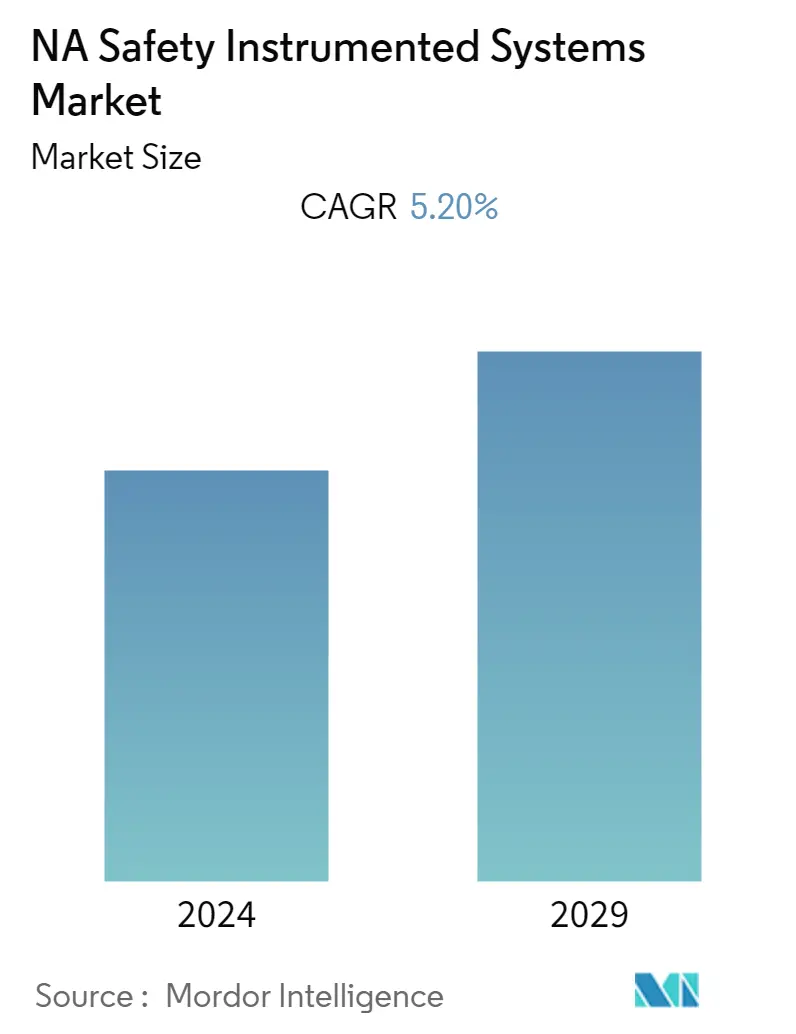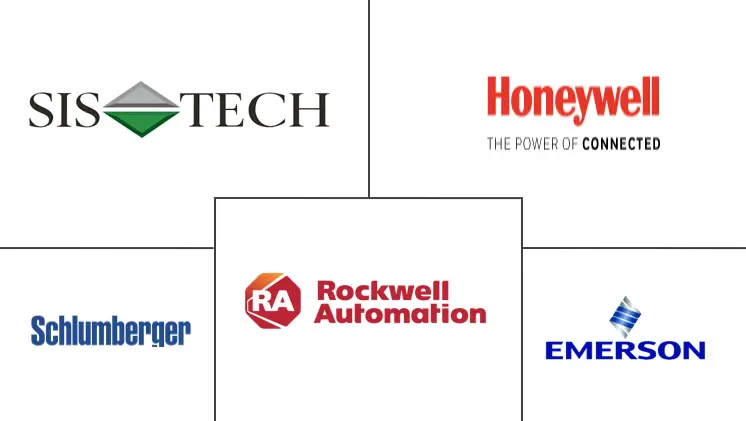Market Size of NA Safety Instrumented Systems Industry

| Study Period | 2019 - 2029 |
| Base Year For Estimation | 2023 |
| Forecast Data Period | 2024 - 2029 |
| Historical Data Period | 2019 - 2022 |
| CAGR | 5.20 % |
| Market Concentration | Medium |
Major Players
*Disclaimer: Major Players sorted in no particular order |
North America Safety Instrumented Systems Market Analysis
The North American safety instrumented system market is expected to register a CAGR of 5.2% during the forecast period. The highest safety standards are set for business employees, communities, and the environment by government regulating organizations like the Occupational Safety and Health Administration (OSHA) and the Environmental Protection Agency (EPA) in the United States and insurance companies.
- Therefore, companies must do a process hazard analysis to identify the actions necessary for the highest level of safety. In addition, as the process industry moves closer to adopting higher safety requirements, control systems that can accommodate changes, including steam turbines, compressors, and variable speed drives, could be required to retain profitability while accommodating changing demands.
- Chemical, petrochemical, mining, gas compression, and many other sorts of catastrophes can make chemical, petrochemical, and industrial facilities very dangerous places to work because of the potential for fire, explosion, tank overflow, gas release, or chemical exposure.
- The idea of defining risks as those associated with processing functions rather than isolated processing lines or tank risks has been adopted by the Occupational Safety and Health Administration (OSHA), several chemical companies, ISA, and other professional groups to reduce such risks.
- The ISA 84 and IEC 61508 standards were created using functional safety ideas. Later, the ISA-84/IEC-61511 standard, known as ISA in the United States and IEC in Europe, was created by combining the two standards. Functional safety would be managed at a facility by establishing a distinctive, well-designed safety instrumented system to avoid functional hazards.
- The COVID-19 pandemic also substantially influenced the development of several sectors as most businesses were forced to halt or curtail their operations due to several government-imposed regulations. The pandemic significantly impacted the adoption of safety instrumented systems.
- For instance, the COVID-19 pandemic-driven worldwide economic downturn and the collapse of the oil market, which temporarily brought the benchmark price for US crude oil to a record low, had unprecedented negative effects on the oil and gas industry, one of the main end users of SIS.
- The latest IEA analysis predicts that by 2026, oil consumption will rise by 104 million barrels per day or 4% more than it did in 2019, suggesting that the market for safety instrumented systems (SIS) will experience rapid expansion in the future.
North America Safety Instrumented Systems Industry Segmentation
The safety instrumented systems (SIS) are in charge of assuring operational safety and an emergency halt within the boundaries of what is deemed safe if an activity crosses those boundaries. The primary goal is to prevent mishaps within and outside of facilities, such as fires, explosions, and equipment damage, protection of production and property, and prevent life-threatening or catastrophic effects on the community and personal health.
The North American safety instrumented systems market is segmented by application (emergency shutdown systems (ESS), fire and gas monitoring and control (F&GC), high integrity pressure protection systems (HIPPS), burner management systems (BMS), turbo machinery control, and other applications), end user (chemicals and petrochemicals, power generation, pharmaceutical, food and beverage, oil and gas, and other end users), and country.
| Application | |
| Emergency Shutdown Systems (ESD) | |
| Fire and Gas Monitoring and Control (F&GC) | |
| High Integrity Pressure Protection Systems (HIPPS) | |
| Burner Management Systems (BMS) | |
| Turbo Machinery Control | |
| Other Applications |
| End User | |
| Chemicals and Petrochemicals | |
| Power Generation | |
| Pharmaceutical | |
| Food and Beverage | |
| Oil and Gas (with a Percentage Breakdown by Upstream, Downstream, and Midstream) | |
| Other End Users |
| Country | |
| United States | |
| Canada |
NA Safety Instrumented Systems Market Size Summary
The North American safety instrumented systems market is poised for significant growth, driven by the increasing need for stringent safety standards across various industries. Regulatory bodies like OSHA and the EPA, along with insurance companies, mandate high safety standards to protect employees, communities, and the environment. This has led to a heightened focus on process hazard analysis and the adoption of advanced control systems to manage risks associated with chemical, petrochemical, and industrial facilities. The market is further bolstered by the integration of functional safety standards such as ISA 84 and IEC 61508, which emphasize the importance of well-designed safety instrumented systems in mitigating functional hazards. The COVID-19 pandemic has had a profound impact on the market, affecting the oil and gas industry significantly, yet it also highlighted the critical need for robust safety systems to navigate economic uncertainties and operational challenges.
The demand for safety instrumented systems is expected to surge, particularly in the petrochemical industry, due to their advantages over traditional safety measures. These systems offer enhanced field life, reduced downtime, and compliance with modern codes and standards, making them indispensable in hazardous working environments. The US market is anticipated to expand rapidly, fueled by urbanization, industrialization, and the increasing risk of industrial disasters. Despite the competitive landscape dominated by major players like Rockwell Automation, Honeywell, and Emerson, the market is characterized by rapid technological advancements and evolving consumer preferences. Strategic collaborations and technological innovations are key to maintaining market share and profitability. Additionally, ongoing infrastructure projects and the United States' leadership in nuclear power generation further contribute to the market's growth prospects.
NA Safety Instrumented Systems Market Size - Table of Contents
-
1. MARKET DYNAMICS
-
1.1 Market Overview
-
1.2 Industry Value Chain Analysis
-
1.3 Industry Attractiveness - Porter's Five Forces Analysis
-
1.3.1 Threat of New Entrants
-
1.3.2 Bargaining Power of Buyers
-
1.3.3 Bargaining Power of Suppliers
-
1.3.4 Threat of Substitute Products
-
1.3.5 Intensity of Competitive Rivalry
-
-
1.4 Assessment of COVID-19 Impact on the Industry
-
1.5 Market Drivers
-
1.5.1 Growing Regulatory Environment in the Industry
-
1.5.2 Presence of Robust SIS Service Ecosystem
-
-
1.6 Market Restraints
-
1.6.1 Operational Complexity and High Maintenance Costs
-
-
-
2. MARKET SEGMENTATION
-
2.1 Application
-
2.1.1 Emergency Shutdown Systems (ESD)
-
2.1.2 Fire and Gas Monitoring and Control (F&GC)
-
2.1.3 High Integrity Pressure Protection Systems (HIPPS)
-
2.1.4 Burner Management Systems (BMS)
-
2.1.5 Turbo Machinery Control
-
2.1.6 Other Applications
-
-
2.2 End User
-
2.2.1 Chemicals and Petrochemicals
-
2.2.2 Power Generation
-
2.2.3 Pharmaceutical
-
2.2.4 Food and Beverage
-
2.2.5 Oil and Gas (with a Percentage Breakdown by Upstream, Downstream, and Midstream)
-
2.2.6 Other End Users
-
-
2.3 Country
-
2.3.1 United States
-
2.3.2 Canada
-
-
NA Safety Instrumented Systems Market Size FAQs
What is the current NA Safety Instrumented Systems Market size?
The NA Safety Instrumented Systems Market is projected to register a CAGR of 5.20% during the forecast period (2024-2029)
Who are the key players in NA Safety Instrumented Systems Market?
Rockwell Automation Inc. , Emerson Electric Co. , Honeywell International Inc. , SIS-TECH Solutions LP and Schlumberger Limited are the major companies operating in the NA Safety Instrumented Systems Market.

